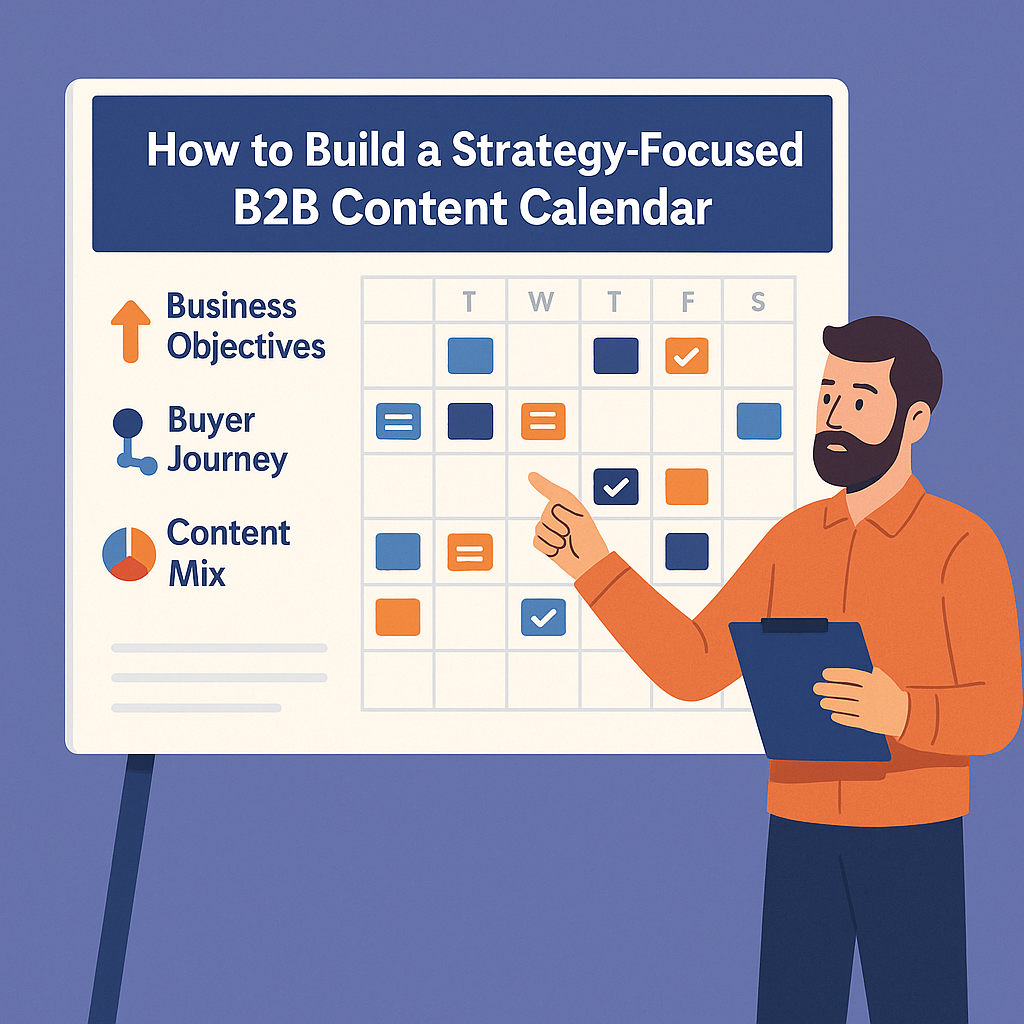You’ve probably been there before—scrambling at the last minute to figure out what content to publish next week, or worse, realizing you’ve been creating content that doesn’t align with your quarterly goals. If this sounds familiar, you’re not alone. Many B2B content marketers struggle with the same challenge: creating a B2B content calendar that actually serves their strategic objectives rather than just filling publishing schedules.
The truth is, most content calendars fail because they’re built backwards. Instead of starting with business goals and buyer needs, teams often begin with available resources or publishing frequencies. This approach leads to content that’s consistent but not strategic, regular but not results-driven.
Let’s fix that. Here’s how to build a B2B content calendar that becomes your most valuable strategic tool rather than just another spreadsheet you dread updating.

Start with Your North Star: Business Objectives
Before you even think about content types or publishing schedules, you need absolute clarity on what your content is supposed to accomplish. This isn’t about vague goals like “increase brand awareness”—you need specific, measurable objectives that tie directly to revenue.
For most B2B organizations, content serves one of three primary functions: generating new leads, nurturing existing prospects through the sales funnel, or enabling sales teams to close deals faster. Your content calendar should reflect this reality.
Begin by mapping your content to specific business outcomes. If you’re focused on lead generation, your calendar should prioritize top-of-funnel content that addresses broad industry challenges. If pipeline acceleration is the goal, middle-funnel content that demonstrates capability and builds trust becomes paramount. When sales enablement is the priority, bottom-funnel content that directly supports the buying decision takes center stage.
The key is choosing your primary objective and ensuring at least 60% of your planned content directly supports it. This focus prevents the common trap of creating content that’s “nice to have” but doesn’t move the needle on what matters most to your business.
Map Content to the Complete Buyer Journey
Your prospects don’t experience your content in isolation—they encounter it as part of a larger journey from problem awareness to purchase decision. Your B2B content calendar should reflect this journey, ensuring you have the right content at the right stages to guide prospects forward.
The mistake most teams make is creating content for the extremes—either very top-of-funnel educational content or very bottom-funnel product-focused content—while neglecting the crucial middle stages where prospects are actively evaluating solutions.
Structure your calendar around the five key stages of the B2B buyer journey. Problem awareness content should help prospects recognize and articulate their challenges. Solution exploration content should position your approach as a viable option without being overly promotional. Vendor evaluation content should provide the detailed information prospects need to assess your capabilities. Purchase decision content should address final concerns and objections. Post-purchase content should ensure successful implementation and identify expansion opportunities.
For each stage, plan content that addresses the specific questions and concerns your prospects have. This isn’t guesswork—talk to your sales team, interview customers, and analyze the questions that come up repeatedly in your sales process. These insights become the foundation for content that actually serves your buyers rather than just filling publishing slots.
Choose Your Content Mix Strategically
Not all content formats are created equal in B2B marketing. Your calendar should reflect a strategic mix that balances reach, engagement, and conversion potential. The most effective B2B content calendars typically follow a 40-40-20 rule: 40% educational content that builds trust and authority, 40% solution-oriented content that demonstrates capability, and 20% promotional content that drives action.
Educational content includes industry research, best practice guides, trend analyses, and thought leadership pieces. This content builds your brand’s credibility and attracts prospects in the early stages of their buyer journey. Solution-oriented content encompasses case studies, methodology explanations, comparison guides, and implementation frameworks. This content helps prospects understand how you solve problems and whether your approach fits their needs. Promotional content covers product announcements, event invitations, and direct calls-to-action. While necessary, this content should be used sparingly to avoid appearing too sales-focused.
Within each category, diversify your formats to match different consumption preferences. Some prospects prefer detailed whitepapers, others want quick video explanations, and still others learn best from interactive tools or webinars. Your content planning templates should account for this diversity, ensuring you’re not defaulting to the same format repeatedly.
Build Flexibility into Your Framework
The best B2B content calendars are structured enough to provide direction but flexible enough to accommodate the unexpected. Industry news, competitive developments, and internal changes will always require adjustments to your planned content. The key is building a framework that can adapt without derailing your overall strategy.
Create content themes rather than rigid topic assignments. Instead of planning “Blog post about email marketing best practices for March 15th,” plan “Email marketing theme for March” with flexibility around specific angles and formats. This approach gives you room to respond to timely opportunities while maintaining strategic focus.
Establish content buckets that can be populated based on current needs. Always-relevant buckets might include industry insights, customer success stories, and methodology explanations. Time-sensitive buckets could cover regulatory changes, seasonal trends, and competitive responses. Emergency buckets should include reactive content like crisis communications or rapid response pieces.
Build buffer time into your calendar. Most teams underestimate how long quality content takes to produce and leave no room for revisions or approval delays. Plan for content to be completed at least one week before its intended publish date, giving you space to refine or pivot if needed.
Align Team Resources with Content Ambitions
Your content calendar is only as good as your team’s ability to execute it. The most common reason B2B content calendars fail is overambitious planning that doesn’t account for actual resource constraints. Be realistic about what your team can produce without sacrificing quality.
Start by auditing your current content production capacity. How long does it typically take to produce different types of content? What’s your approval process timeline? How much time do subject matter experts actually have available for content creation? These realities should inform your publishing frequency and content complexity.
Assign clear ownership for each piece of content, including both creation and promotion responsibilities. Many teams focus solely on content creation while neglecting distribution, leading to great content that nobody sees. Your editorial calendar best practices should include promotion planning alongside content planning.
Consider seasonal capacity fluctuations. Q4 budget cycles, conference seasons, and holiday periods all impact your team’s availability. Plan lighter content loads during busy periods and heavier production during slower times. This approach ensures consistent output without burning out your team.
Measure What Matters Most
Your B2B content calendar should include measurement plans from the beginning, not as an afterthought. Define success metrics for each piece of content based on its intended purpose within your overall strategy. Top-funnel content might be measured by reach and engagement, while bottom-funnel content should be evaluated based on conversion rates and sales impact.
Establish both leading and lagging indicators for your content performance. Leading indicators like content completion rates, publishing frequency, and social engagement provide early signals about your calendar’s effectiveness. Lagging indicators like lead generation, pipeline influence, and customer acquisition show the ultimate business impact of your content efforts.
Build regular review cycles into your calendar management process. Monthly reviews should assess content performance and identify opportunities for optimization. Quarterly reviews should evaluate whether your content mix is supporting your business objectives and driving the results you need. Annual reviews should inform strategic adjustments to your overall content approach.
Technology and Tools That Actually Help
The right tools can make or break your B2B content calendar execution. Choose platforms that facilitate collaboration, streamline workflows, and provide visibility into your content pipeline. The best content management tools integrate with your existing marketing technology stack and provide automated reporting on content performance.
Look for features that support your specific workflow needs. Multi-level approval processes, automated publishing, social media integration, and performance analytics are table stakes for most B2B teams. Advanced features like content personalization, A/B testing capabilities, and CRM integration can provide additional value for larger organizations.
Remember that tools should enhance your process, not complicate it. The most sophisticated platform won’t help if your team finds it too complex to use consistently. Sometimes a well-structured spreadsheet serves better than an expensive tool that sits unused.
Making Your Calendar a Living Strategic Document
Your B2B content calendar should evolve continuously based on performance data, market changes, and business needs. The most successful content teams treat their calendars as living documents that guide decision-making rather than rigid schedules that must be followed regardless of circumstances.
Establish regular planning cycles that align with your business rhythm. Many B2B companies find quarterly planning cycles work well, providing enough structure to maintain strategic focus while allowing flexibility for tactical adjustments. Monthly planning sessions can fine-tune upcoming content based on recent performance and emerging opportunities.
Document your content creation process and decision-making criteria. When team members understand why certain content decisions were made, they can make better choices when situations require quick pivots. This institutional knowledge becomes especially valuable as teams grow and change.
The goal isn’t perfection—it’s progress. Your first content calendar won’t be perfect, and that’s okay. The important thing is starting with a strategic foundation and improving based on real-world results. Focus on creating content that serves your buyers’ needs while supporting your business objectives, and adjust your approach based on what you learn along the way.
A well-structured B2B content calendar becomes more than just a planning tool—it becomes the backbone of your content marketing strategy. When built thoughtfully and managed consistently, it transforms content creation from a reactive scramble into a proactive competitive advantage. The key is remembering that the calendar serves the strategy, not the other way around.
